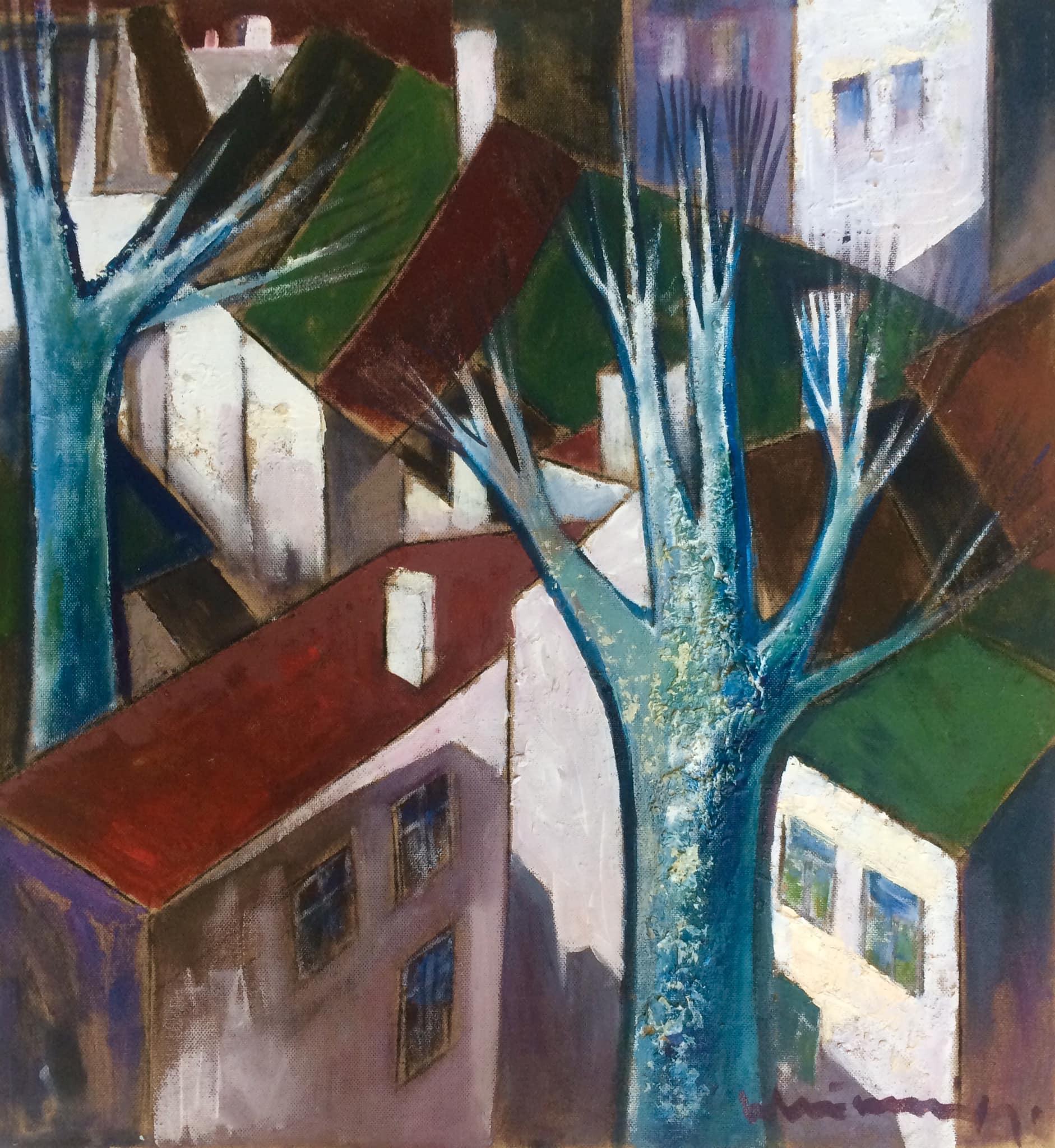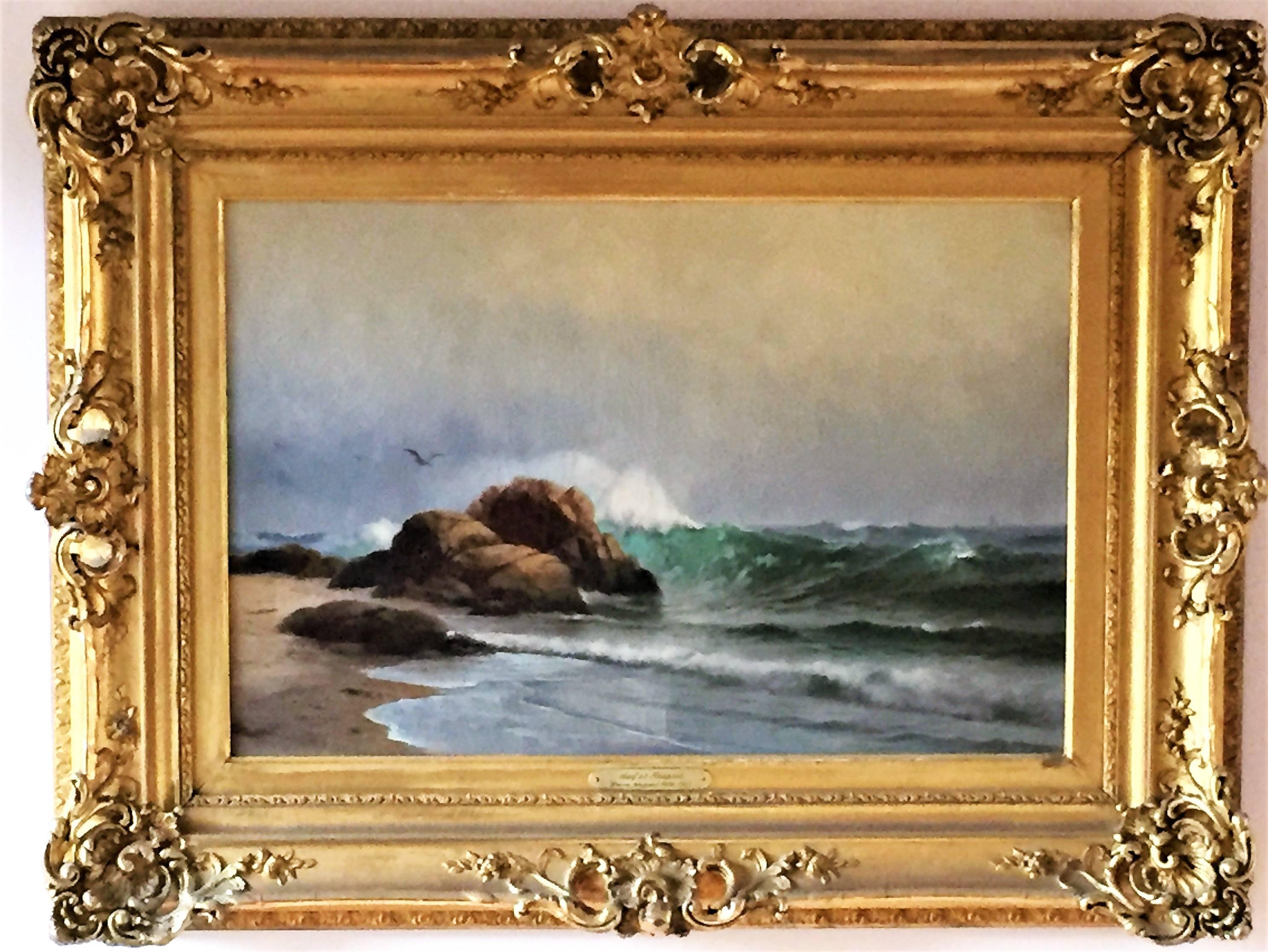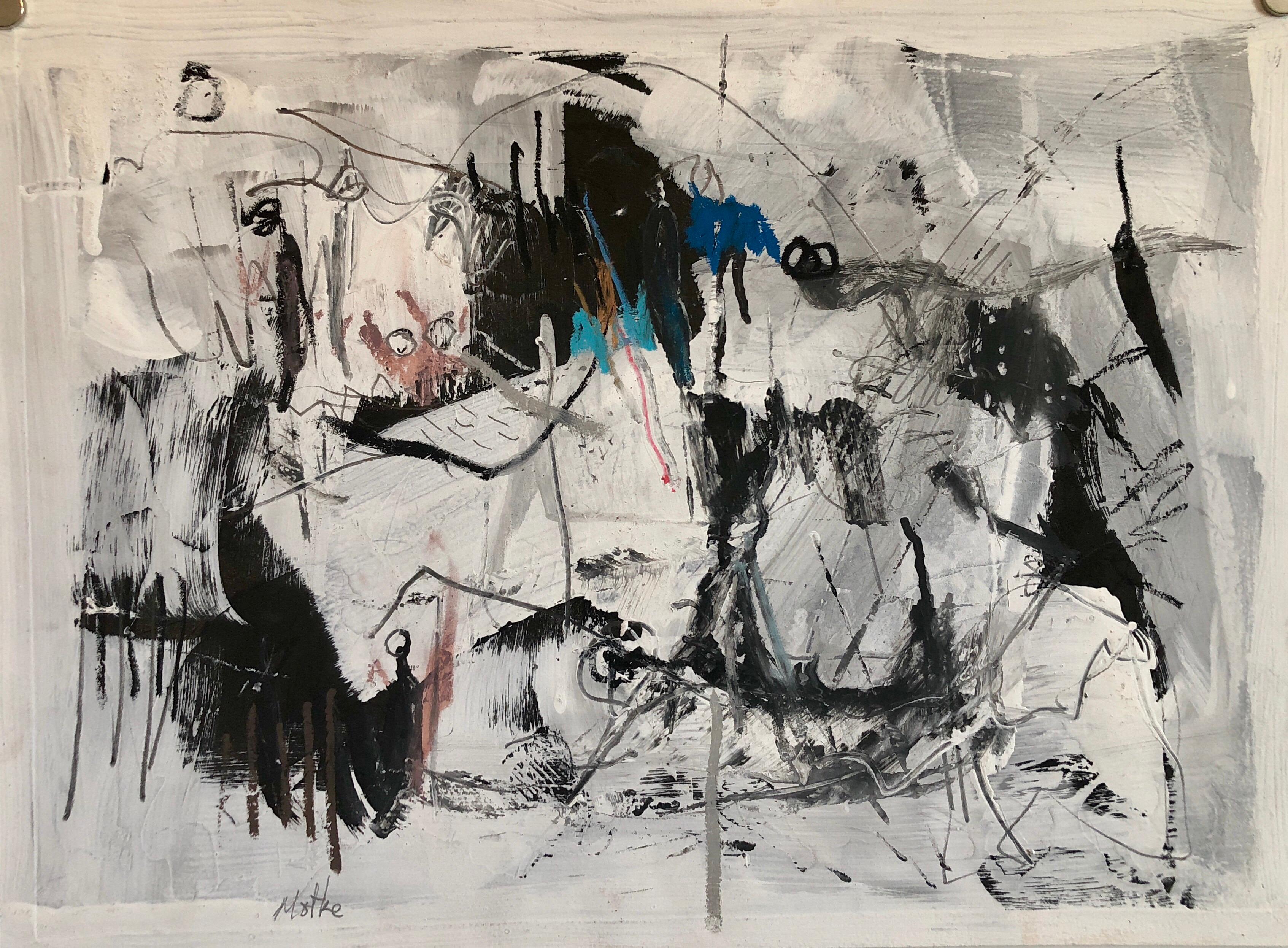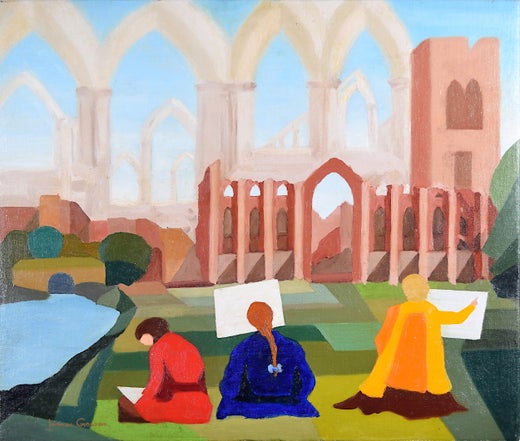James GowanJames Gowan FRIBA Blue Mill at Backbarrow Modernist Architect Leicester 1973
1973
About the Item
- Creator:James Gowan (1923 - 2015)
- Creation Year:1973
- Dimensions:Height: 24.41 in (62 cm)Width: 20.48 in (52 cm)
- Medium:
- Movement & Style:
- Period:
- Condition:Generally excellent condition, relined.
- Gallery Location:London, GB
- Reference Number:1stDibs: LU79535134191
James Gowan
James Gowan studied at the Glasgow School of Art and Kingston School of Architecture where he was taught by Philip Powell of Powell & Moya, who subsequently employed him on the winning entry to the Skylon Competition for the Festival of Britain in 1951. Following a period working on Stevenage New Town, he joined Lyons Israel Ellis, where he met James Stirling. They were quickly established as one of the most radical practices of their generation when they designed Langham House Close on Ham Common (West London) in 1958 — a reaction against all that had gone before them. Gowan and Stirling took equal parts in the design of their early projects, culminating with the 1963 Engineering Building at the University of Leicester, considered the first postmodernist building in Britain. Shortly after the building was completed, the two split acrimoniously, Stirling taking the lion's share of the credit. The Engineering Building represented a massive shift from the postwar era's functionalist doctrines, bringing in forceful geometries and dynamic structural feats in what was subsequently called the 'engineering style'. Two cantilevered lecture theatres are topped by a pair of glazed towers, clad in red Dutch tiles, monolithic wedges inspired by the superstructure of an aircraft carrier; the workshop building is surmounted by a crystalline roof with rippling waves that let in north-facing light. An almost Gothic feel to the design, with concrete columns supporting the building like mediaeval flying buttresses, was later described by Gowan as "the Picasso profile with the big eye slapped on the front". The visually stunning and highly practical building caused the architects to be awarded the Reynolds Award from the American Institute of Architects and was Grade II* listed in 1993.
- ShippingRetrieving quote...Ships From: London, United Kingdom
- Return PolicyA return for this item may be initiated within 14 days of delivery.
- James Gowan FRIBA Fountains Abbey Modernist Architect Leicester EngineeringBy James GowanLocated in London, GBPost-war architect partner of architect Sir James Stirling, together they created Britain's first post-modernist building, Gowan being the talented shy ...Category
Mid-20th Century Modern Landscape Paintings
MaterialsOil
- Sir Terry Frost RA: 'Untitled Landscape' oil on canvas 1991 paintingBy Sir Terry FrostLocated in London, GBTo see our other Modern British Art, scroll down to "More from this Seller" and below it click on "See all from this Seller" - or send us a message if you cannot find the artist you ...Category
1990s Abstract Landscape Paintings
MaterialsCanvas, Oil
- Ethel Louise Rawlins: 'A Garden Below the South Downs' oil paintingLocated in London, GBTo see our other Modern British Art, scroll down to "More from this Seller" and below it click on "See all from this Seller" - or send us a message if you cannot find the artist you want. Ethel Louise Rawlins (1880 - 1940) A Garden Below the South Downs...Category
Early 20th Century Modern Landscape Paintings
MaterialsOil, Canvas
- Roy Carnon: 'All Hallows Church, Tillington, near Petworth' oil paintingLocated in London, GBTo see our other Modern British Art, scroll down to "More from this Seller" and below it click on "See all from this Seller" - or send us a message if you cannot find the artist you want. Roy Carnon...Category
Mid-20th Century Modern Landscape Paintings
MaterialsBoard, Oil
- J Phillip Davies: Selwyn College Cambridge - oil painting: Modern British ArtBy J. Phillip DaviesLocated in London, GBJ Phillip Davies (British, 20th Century) Selwyn College Cambridge oil on board c. 1970 60x89cmCategory
1970s Modern Landscape Paintings
MaterialsOil
- Lionel Bulmer The Edge of the Field Oil on board c. 1950By Lionel BulmerLocated in London, GBLionel Bulmer (1919-1992) 'The Edge of the Field' Signed c.1950s Oil on board 17" x 20" (43 x 51cm) Lionel Bulmer (1919-1992) attended Clapham art school before war intervened; after the war he started again at the Royal College of Art which had been relocated during the conflict to Ambleside in the Lake District. Here he met his lifelong partner Margaret Green...Category
1950s Modern Landscape Paintings
MaterialsOil
- Reed 22 November 09:54 - Modern Nature Oil Painting, Abstract, MinimalismBy Robert MotelskiLocated in Salzburg, ATRobert Motelski's paintings are exceptional visions of nature, visions of space which surrounds us. They tell about being, fate and passing. They depend on the season of year, the ti...Category
2010s Modern Landscape Paintings
MaterialsCanvas, Oil
- Roofs. 1991, oil on cardboard 91x85 cmLocated in Riga, LVLaimdots Murnieks had a significant influence on the development of Latvian painting at the end of the 20th century. His work 'Holiday' conveys the feeling lightness and joy, which i...Category
1990s Modern Landscape Paintings
MaterialsOil, Cardboard
- 1963 Vintage Mid-Century Abstract Seascape Oil Painting - Coastal ThunderstormLocated in Bristol, GBCOASTAL THUNDERSTORM Size: 52.5 x 70 cm (including frame) Oil on Canvas An emotive and wonderfully executed mid-century abstract artwork, painted in oil onto canvas and dated 1963. ...Category
1960s Modern Landscape Paintings
MaterialsCanvas, Oil
- The Surf at NewportBy Warren W. SheppardLocated in Storrs, CTThe Surf at Newport (Rhode Island). c. 1906. Oil on canvas. 17 x 24 (framed 26 x 34). Lined; extensive craquelure; otherwise fine condition. Housed in an exceptional Louis XV (reviva...Category
Early 20th Century American Modern Landscape Paintings
MaterialsOil
- Israeli Modernist Abstract Expressionist Seascape Oil Painting Tel Aviv HarborBy Motke BlumLocated in Surfside, FLIn this artwork the artist uses the medium spontaneously .The paint has been applied thickly to the surface. The resulting work emphasizes the physical act of painting itself as an essential aspect of the finished work or concern of the artist. size is with frame. Motke Blum was born in Racacun, Romania in 1925. Early in his childhood, the Blum family moved to Bukarest where they settled in a house situated near a circus. The circus would become young Blum's greatest love. He befriended several of the clowns and other performers and, when not painting or playing in clay, Blum could be found enjoyoing the company of these spirited entertainers. These experiences would later become a recurring theme in many of his works of art. In 1938, he was taken by the Romanian Iron Guard. When the Germans invaded Romania, Blum was taken to a forced labor camp. Even during his imprisonment, he continued to create art, painting on the walls of the camp. He escaped the camp in 1944 and boarded an immigrants' ship to Israel. One of the three ships in the convoy was sunk by a German torpedo. Motke later incorporated shipwrecks, boats, and other maritime subjects into several of his paintings. Over the course of his long and fruitful career, Blum showed internationally at over fifty one-man-shows with exhibits in Israel, Holland, England, Belgium, the United States, France, Australia, and more. His art has been commissioned for public buildings and by prominant figures in Israel and around the world, and a series of posters were commissioned by the Justice Ministry and the Ministry of Tourism. Giving back to the community has been a focus throughout his life. After establishing a studio at Chutzot Hayotzer, Motke welcomed schools and both adults and children with special needs, using painting...Category
Mid-20th Century Modern Abstract Paintings
MaterialsCanvas, Oil
- Israeli Motke Blum Modernist Abstract Expressionist Oil Painting Bezalel ArtistBy Motke BlumLocated in Surfside, FLMotke Blum was born in Racacun, Romania in 1925. Early in his childhood, the Blum family moved to Bucharest where they settled in a house situated near a circus. The circus would become young Blum's greatest love. He befriended several of the clowns and other performers and, when not painting or playing in clay, Blum could be found enjoying the company of these spirited entertainers. These experiences would later become a recurring theme in many of his works of art. In 1938, he was taken by the Romanian Iron Guard. When the Germans invaded Romania, Blum was taken to a forced labor camp. Even during his imprisonment, he continued to create art, painting on the walls of the camp. He escaped the Nazi camp in 1944 and boarded an immigrants' ship to Israel. One of the three ships in the convoy was sunk by a German torpedo. Motke later incorporated shipwrecks, boats, and other maritime subjects into several of his paintings. Studies, Bezalel, Jerusalem, Enamel, Silversmithing, Painting and Sculpture. 1956 Seminar in the dep. of design in the royal silver factory of Zeist, The Netherlands. Over the course of his long and fruitful career, Blum showed internationally at over fifty one-man-shows with exhibits in Israel, Holland, England, Belgium, the United States, France, Australia, and more. His art has been commissioned for public buildings and by prominent figures in Israel and around the world, and a series of posters were commissioned by the Justice Ministry and the Ministry of Tourism. Group exhibition Rina Gallery, Jerusalem Artists: Motke Blum, Efraim Fima (Roytenberg, Ephraim) Zelig Segal, David Sharir, Joseph Halevi...Category
20th Century Modern Abstract Paintings
MaterialsMixed Media, Oil, Illustration Board





